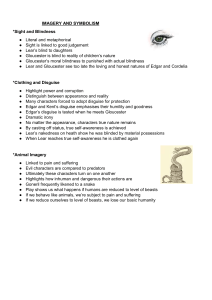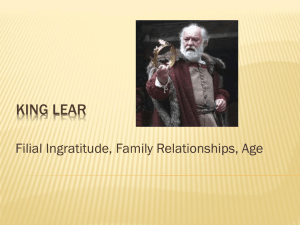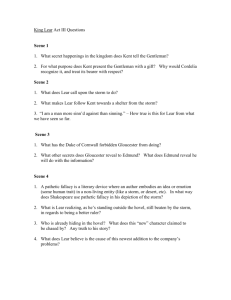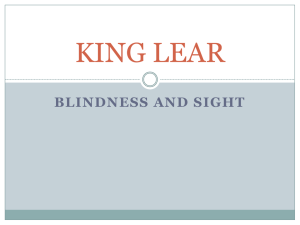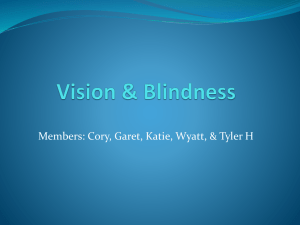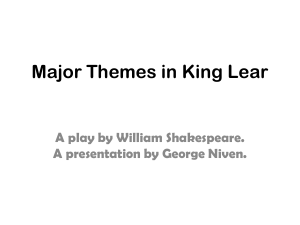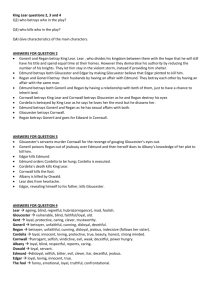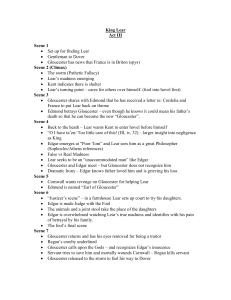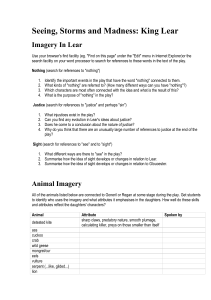Themes in King Lear
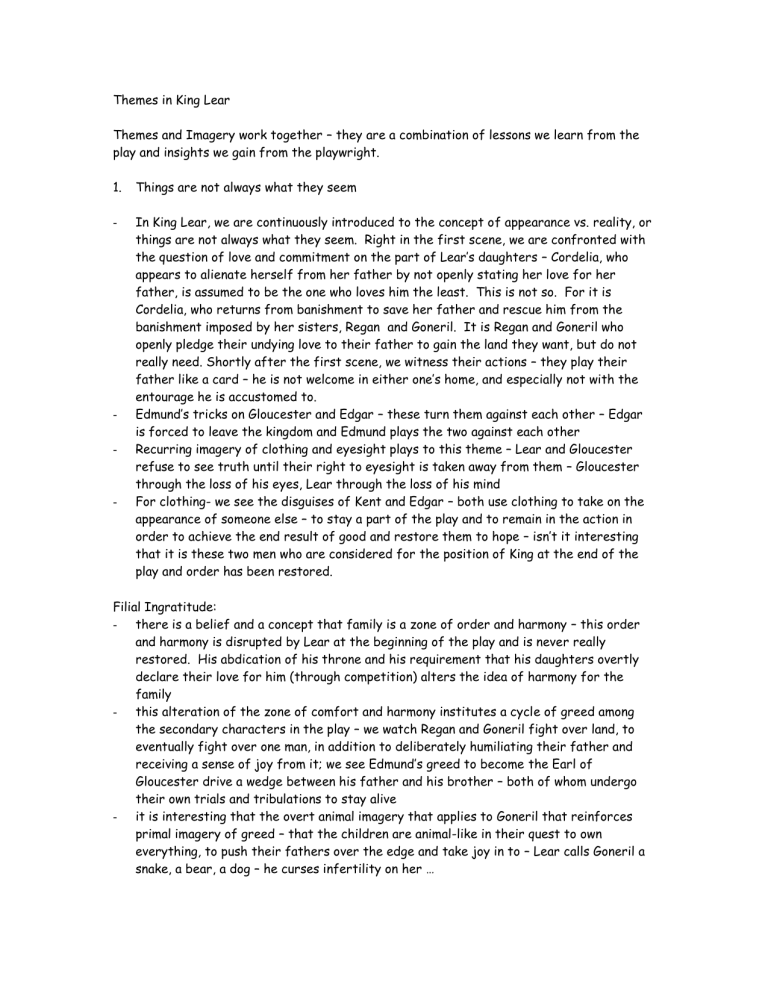
Themes in King Lear
Themes and Imagery work together – they are a combination of lessons we learn from the play and insights we gain from the playwright.
1.
Things are not always what they seem
-
In King Lear, we are continuously introduced to the concept of appearance vs. reality, or things are not always what they seem. Right in the first scene, we are confronted with the question of love and commitment on the part of Lear’s daughters – Cordelia, who appears to alienate herself from her father by not openly stating her love for her father, is assumed to be the one who loves him the least. This is not so. For it is
Cordelia, who returns from banishment to save her father and rescue him from the banishment imposed by her sisters, Regan and Goneril. It is Regan and Goneril who openly pledge their undying love to their father to gain the land they want, but do not really need. Shortly after the first scene, we witness their actions – they play their father like a card – he is not welcome in either one’s home, and especially not with the entourage he is accustomed to.
-
Edmund’s tricks on Gloucester and Edgar – these turn them against each other – Edgar is forced to leave the kingdom and Edmund plays the two against each other
-
Recurring imagery of clothing and eyesight plays to this theme – Lear and Gloucester refuse to see truth until their right to eyesight is taken away from them – Gloucester through the loss of his eyes, Lear through the loss of his mind
-
For clothing- we see the disguises of Kent and Edgar – both use clothing to take on the appearance of someone else – to stay a part of the play and to remain in the action in order to achieve the end result of good and restore them to hope – isn’t it interesting that it is these two men who are considered for the position of King at the end of the play and order has been restored.
Filial Ingratitude:
there is a belief and a concept that family is a zone of order and harmony – this order and harmony is disrupted by Lear at the beginning of the play and is never really restored. His abdication of his throne and his requirement that his daughters overtly declare their love for him (through competition) alters the idea of harmony for the family
this alteration of the zone of comfort and harmony institutes a cycle of greed among the secondary characters in the play – we watch Regan and Goneril fight over land, to eventually fight over one man, in addition to deliberately humiliating their father and receiving a sense of joy from it; we see Edmund’s greed to become the Earl of
Gloucester drive a wedge between his father and his brother – both of whom undergo their own trials and tribulations to stay alive
it is interesting that the overt animal imagery that applies to Goneril that reinforces primal imagery of greed – that the children are animal-like in their quest to own everything, to push their fathers over the edge and take joy in to – Lear calls Goneril a snake, a bear, a dog – he curses infertility on her …
this filial ingratitude – the idea that What parents provide for their children is simply not enough to make everyone happy – brings chaos to the play and immense suffering to all. Can you name one person in this play who does not suffer to some extent!
Self-Realization – Suffering can transform a contemptible human being into a good person.
we may not see Gloucester as a contemptible human being, but it is Gloucester who is mocking his son Edmund as a bastard in Act 1, scene 1. It has been argued that it is
Gloucester's attitude towards Edmund that fuels Edmund’s desire to own and become the Earl of Gloucester; whether this is true or not, Gloucester also willingly submits to
Edmund’s trickery and deception – believing that Edgar has plotted to kill him, despite the fact that Gloucester has never had any reason to believe that Edgar would do so;
this evidence alone could convince us that Gloucester is a somewhat contemptible person, and while the action of having one’s eyes being plucked out is gruesome and somewhat unnecessary, do we not feel just a little relief that Gloucester is able and willing to see the truth about his sons once he has endured such pain and lost the gift of sight? As we have previously discussed that it is interesting that eyes do not actually allow us to see the truth it is our heart that lets us do that.
-
Lear’s suffering is also seen through his trips into madness – as he descends further and further, we see one is railing against the realities of life – he cannot see how or why his children would deceive or betray him and suffers excessively from the idea that even though he thought he lost only one daughter, he in fact, lost all three of them through dividing his land
-
Unfortunately, it is only being left out in the storm, alone to rage against it that brings him some awareness of suffering he has endured and, the caring and kind actions and companionship of the Fool, and Kent bring him around and make him aware that compassion and caring actions are necessary and possible
-
The imagery of disease and plagues fall nicely into this theme – we see
